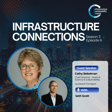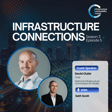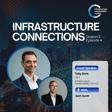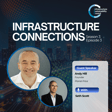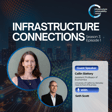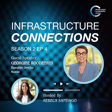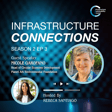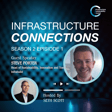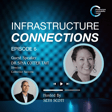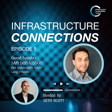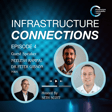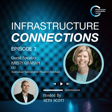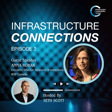Become a Creator today!Start creating today - Share your story with the world!
Start for free
00:00:00
00:00:01

Episode 1 - Season Opener w/ Toby Kent
Host Seth Scott discusses with Guest Speaker, Toby Kent, Infrastructure Sustainability Council's CEO about his view of the future of sustainable infrastructure and the role resilience plays in infrastructure based on his previous experience as Melbourne's Chief Resilience Officer.
Transcript
Introduction to 'Infrastructure Connections' with Seth Scott
00:00:00
Speaker
People have a tendency often to think about infrastructure in terms of and the most the the biggest projects, the biggest bridges, the high speed rails, whatever it may be.
00:00:12
Speaker
But actually part of our future also has to be about um better connectivity. and
00:00:24
Speaker
Welcome to Infrastructure Connections, the podcast where we explore what makes sustainable infrastructure work. Brought to you by the Infrastructure Sustainability Council. I'm your host, Seth Scott.
Toby Kent on Market Engagement and Team Management
00:00:36
Speaker
Today, we'll be speaking to Toby Kent, our CEO, about the future of infrastructure. So without further ado, let's get introduced. Thanks, Scott. I'm Toby Kent, CEO of the Infrastructure Statability Council.
00:00:50
Speaker
In terms of focus, I really look at three things. So fundamentally, how we engage ah with the market and our members, how we make sure that the products and the services that we produce are best serving the needs of the market and those members.
00:01:06
Speaker
And of course, looking after the incredible team, including yourself, that we have here at the ISC. That's a great role. So you've been involved in sustainability for most of your career.
The Origins of Toby's Interest in Sustainability
00:01:16
Speaker
What was the spark that inspired you to dive into sustainability?
00:01:21
Speaker
There were probably a few sparks at different moments, if I'm really honest. And why wouldn't I be? ah It goes back a long time. i was doing research in the former Soviet Union in the late 1990s, and I became really interested as I was looking at ah socioeconomic development issues, how these newly independent nation states of Tajikistan, Uzbekistan, Kyrgyzstan and so forth um were going to become successful. And I became really, really interested in the role of the corporate sector in in that. And I got into um what then we called corporate social responsibility, which kind of evolved through various iterations through corporate sustainability and and so on. and
00:02:06
Speaker
um Yeah, and as I say, there were kind of different a sparks along the way, different sectors that I got into, etc. But that was the real origins of it. Was there anyone who inspired you along the way?
Career Advice and Vision for Future Infrastructure
00:02:20
Speaker
but i mean, it sounds maybe a little trite. I don't know. know um There was actually something that happened coming out at the time in Central Asia where I was asked by...
00:02:31
Speaker
and one of the universities that I did some work with there to put together a funding proposal for an EU grant, European Union academic grant.
00:02:43
Speaker
And um went to my dad and i was like, I really don't know what I'm doing. you got any thoughts? And he said, listen, and as well as being slightly more helpful than this, he said, listen, fundamentally, that he said there are no experts.
00:02:57
Speaker
He said, there are just people who do things and they become experts. And so I guess that's really played a um real influence on how I've approached my career. That was, again, really as i well, you know, on the cusp of starting my career, I guess.
00:03:12
Speaker
And just having that sense of give things a go. Can we, you know, it, you will be able to work it out. And if you can't, you know it will work out if you stick at it and so on. So I guess that's been a ah both an influence and a theme that's run through my career.
00:03:29
Speaker
Well, I think you've become an expert by now.
00:03:32
Speaker
One hopes. There's still areas that you can always learn. Yeah, exactly. And because also everything keeps
Integrating Infrastructure with Nature and Society
00:03:39
Speaker
moving, right? And then ah we are obviously at a point in history, ah not least in the infrastructure space, where and the expectations to ah do things differently and the need to do things differently are extremely high and fast moving. So I don't think anyone there iss an ex anyone who thinks they're an expert for a long time without keeping to work at it is going to get left behind.
00:04:05
Speaker
That's true. Well, speaking of what's coming in the future, on this season we're talking about the future of infrastructure. So kick us up with a wide lens. um What's your vision for the future? Where are we going to be in 15, 30 or even 50 years? Just go long.
00:04:21
Speaker
Yeah. and So... I'm going to paint an an off optimistic ah vision. I think i've I've done quite a lot of work on scenario planning as various points in my career.
00:04:37
Speaker
you know and And the way that one approaches that, as I'm sure our listeners fully understand, is to look at um what are plausible scenarios. And you normally pick a few scenarios because then we really don't know.
00:04:51
Speaker
So i'm goingnna i'm um i as say I'm going to pick a an optimistic vision in which I think there is a part of that optimistic future and that also looks a little bit more like our past.
00:05:08
Speaker
And what I mean by that is it is a future ah in which despite an ongoing population increase, ah we have found ways to ah integrate, interact ah much better with nature. So we do actually see recovery of the natural environment.
00:05:30
Speaker
there will ah The thing that is different, I think, in part to the future in relation to nature is that there is going to be a necessary role for human intervention in achieving that, whether that's rebuilding nature.
00:05:49
Speaker
rebuilding reefs um with the use of robots and other human interventions, whether it's ah more sophisticated technologies to extract carbon from the atmosphere.
00:06:03
Speaker
Right now, um Probably the most sophisticated technology to extract carbon from the atmosphere is trees um and vegetation, which have done that extremely well.
00:06:15
Speaker
ah But in and of them, you know, there probably is a role, as I say, for that human bit in how we... um both use technology to extract carbon ah as in true human-created technology, and also then how we use ah other forms, artificial intelligence, et cetera, to work out where best and how to ah reforest, et cetera.
00:06:39
Speaker
So I think that'll be part of it. think um my instinct is that if you imagine popping up in a city in hopefully 15, certainly 30 or 50 years time, I think you will see more elderly people and more disabled people in our streets. And that's because actually my sense of the future is not that we are going to
00:07:12
Speaker
um either genetically engineer our way out of the um realities of disability, ah nor are we going to ah technologically evolve our way out of aging.
00:07:27
Speaker
um But I do think we, with more a sensitive and intelligent infrastructure in particular, I do see a way to make, not just, I did focus on that on the cities, but not just the urban space, but our societies generally ah more accessible and more inclusive.
00:07:47
Speaker
Um, and I think that something that flows through that as well. So maybe the third element, uh, this, uh, of this future and the use of infrastructure to connect is um is is is a reconnection of ah communities.
00:08:06
Speaker
ah you know I think we're going through a moment as we have done many times in in human history where the introduction of technology outpaces the speed of social mores and ways of behaving. And we see there are so many different independent studies being done about the negative impacts of just, for example, it's not all about social media, but social media, etc.
00:08:35
Speaker
um We're also seeing that as ah infrastructure is more stressed with growing populations, that people are spending having less time to spend in their communities. So I think ah thinking about the way that infrastructure enables um the people to not be stuck in traffic for hours commuting to jobs, etc.,
00:09:02
Speaker
um is going to be a critical part of that more ah optimistic vision.
The Future of Regenerative Infrastructure
00:09:10
Speaker
So as I said, I think in if I'm sort of bringing it down to three areas of really being around a more regenerative ah natural environment and one as part of that in which we see nature not as, at and the moment, on the whole, and I'm being a bit oversimplistic and I'm not talking in sound bites, so I will try to summarize this.
00:09:31
Speaker
um At the moment, ah
00:09:36
Speaker
as I say, an oversimplification, but we tend to go, ah if the good practice in infrastructure is thinking about how we can reduce our negative environmental impacts.
00:09:48
Speaker
um Going forwards, I think, and we're beginning to see it, but we will have a much, much stronger attention to how we can actually use nature and thus promote nature ah to achieve some of the outcomes that we want from our infrastructure.
00:10:05
Speaker
obvious areas around coastal protection, stormwater management, et cetera, but not only in those spaces. and So it comes back to working much better in, as I say, regenerative nature, um more inclusive societies and better connected communities.
00:10:23
Speaker
That's fantastic. Well, that definitely is a positive view. And I like the idea of working to make things more positive rather than trying to make them less negative. Yeah, invite me on and back again and I'll give you my dystopian view of the future.
00:10:41
Speaker
That'll be the next episode. So the the future looks bright based on that kind of optimism. And I think that's great. But of course, we have to get there somehow. And in the present, we seem to be in a bit of a holding pattern with economic and political pressures that we're seeing.
Balancing Economic Pressures and Sustainability in Infrastructure
00:10:56
Speaker
um Meanwhile, the infrastructure we do build manages to achieve some amazing sustainability outcomes and the projects in the pipeline are also looking quite innovative. But from your position with the ISC, what direction is the infrastructure headed in today?
00:11:12
Speaker
What kind of obstacles are we facing to reach that positive future? Yeah, so a lot of discussion in both Australia and New Zealand about value from R&D.
00:11:25
Speaker
Infrastructure should always be about delivering value for money. The issue we have at the moment is people are using the phrase value for money, but they're really talking about cost today.
00:11:40
Speaker
And i think part of that, sort of if you can just sort of hold on to that thought, We also have a situation as a second point um linked to this holding pattern, economic pressures, value for money, etc.
00:11:58
Speaker
where i think people have lost, too many people have lost sight of the framing of sustainability, which it comes from that broader concept of sustainable, couple them slightly extended words of sustainable development.
00:12:17
Speaker
So sustainable development is fundamentally about striking a sensible balance between the social, the economic and the environmental impacts. And too often what we're seeing is people are talking about ah environmental sustainability and red tape, green tape ah and getting in the way. But if we say...
00:12:38
Speaker
that our infrastructure is inherently multi-generational and the consequences of it are also multi-generational, then ah value for money needs to be seen through a lens which includes the price that we're paying today, but also says,
00:12:56
Speaker
Well, what are these broader impacts that we're trying to manage? Ultimately, increasing social outcomes and reducing negative so and environmental benefits, or to my earlier point, ideally, actually supporting regenerative ah environmental outcomes.
00:13:14
Speaker
and So we're seeing some great things going on across um roads, rail, ports, energy, and I'm loving some of the work that we're doing in the water space at the moment.
00:13:26
Speaker
So, so it's not as though it's all of this good, broader thinking has been thrown out um ah in any way. But what we're seeing is a squeeze on some of the larger infrastructure projects, which is sometimes where you get more headline kind of ramming issues.
00:13:45
Speaker
But I think we' we're also seeing um um a much more um some fundamentals around sustainability ah built in into our infrastructure projects, particularly in Australia with ah the focus on on carbon.
00:14:02
Speaker
There is an issue, I would say, that we've perhaps got almost gone a little bit too overweight, ah to use an investment term, on on the carbon piece, and potentially at the expense of the broader balance between social, economic and environment. One of the ways that I sometimes say is that almost everything is impacted by ah climate change, but certainly not everything is climate change. And so we do need to ah disaggregate those things.
00:14:33
Speaker
So that's quite a long answer. But I guess I would say, ah to summarize that, Essentially, and you've framed it in your question, there are so many good things ah going on ah across ah the infrastructure space, both in Australia and New Zealand.
00:14:49
Speaker
The scale of many projects are coming down, but we're also seeing ah really good practices being ah built into projects of all scales. So the the sustainability itself has been building. you see that continuing to build as a factor in infrastructure moving forward?
00:15:09
Speaker
I think it's the kind of thing that in political environments like this as a as a topic sometimes gets positioned as unnecessarily unnecessary and can be given a bit of a kicking.
00:15:28
Speaker
i mean, being in this space for ah quarter of a century now, um I do think there are peaks and troughs. And I think the fundamentals around being more climate resilient about a greater awareness of um building for a community ah connection, et cetera, are quite strong in our countries.
00:15:53
Speaker
And I would, I think, yeah, fundamentally sustainability is very much here to say whether or not that term is always used. That's great. That's good news.
Characteristics of Resilient Infrastructure
00:16:03
Speaker
So before you came to the ISC, you were the chief resilience officer in a previous role for the city of Melbourne.
00:16:10
Speaker
um And now we see resilience going to be playing a pretty large role in any of the trials and tribulations coming our way. So that helps us prepare for the future. What makes infrastructure resilient and what did you see in your work in that area that is going to make an impact in the future?
00:16:28
Speaker
Yeah, so quite often people think about infrastructure resilience as just building a bigger wall, bigger seawall, pouring more concrete and so One of the things that, of the many great things that were driven by the Global Resilient Cities Initiative,
00:16:48
Speaker
um were quite as simple, I found them very valuable, seven characteristics are of resilience. And these play out at a community level, they play out in, you know, I even applied it in thinking about um when I was looking for a new house, ah you know, and you know, how, so um but But really, um so the point about infrastructure, I find it really valuable. So there four and the way I remember it is four R's, two I's, and an F. So firstly, reflective. Is the infrastructure being designed in ways and maintained in ways that is learning from the past?
00:17:30
Speaker
um It has to be robust and that maybe speaks for itself, but it also has to be resourceful. So um for example, have we got ways that,
00:17:41
Speaker
um ah it also has to be resourceful. So for example, has it got alternative methods of delivery um or can it be used in different ways?
00:17:54
Speaker
um And then redundant, which is about having spare capacity in the system. But importantly as well, it's not just about seeing those some standalone qualities that I just mentioned there.
00:18:06
Speaker
Also, is the infrastructure inclusive? So does it um really think about being designed for those who are the most marginal in societies or marginalized in society as much as the majority or in some cases just the wealthiest?
00:18:25
Speaker
um And is it then integrated itself? I know in planning for the podcast, we've got people coming up who are going to be talking about intelligent infrastructure, for example.
00:18:36
Speaker
And so a critical part of intelligent infrastructure is how well does it integrate with other systems? um You can't really have ah intelligent infrastructure if it's just a sort of and as it were, an island or asset on its own.
00:18:53
Speaker
um And then ah is it flexible? you know um In our work, ah we we don't so much look at buildings, but a great example I like for flexible that lot of the cities around the Resilient Cities Network use was taking a look at school buildings, which are, frequently, you know, ah only really used by a community between about 9 a.m. and 3 p.m.
00:19:23
Speaker
in many cases. So how do you take an asset like that, open it up so it becomes, ah you know, something that he used at night by people who might maybe older people studying or how does it become a drop-in sender? How does it become an area ah that in, you know, maybe in vacation periods might actually also be and a um community project um ah safety, how does it in in areas of times of vacation, for example, um become a community um evacuation center?
00:19:57
Speaker
Often that does happen by um default, by the way, it's worth mentioning, but so much this is is about how do we do things intentionally. ah intentionally So I think that's ah where I would go to to describe what makes infrastructure resilient, those seven qualities. I really like um those. I think they're quite understandable.
00:20:21
Speaker
To give you ah an example um of what that might look like, in New Orleans following Hurricane Katrina, There was a big move ah initially to um build a much, much bigger storm wall involving literally millions and millions of tons of concrete.
00:20:43
Speaker
And what they ended up doing was saying, well, one of the reasons um that...
00:20:50
Speaker
one of the ways we have to protect is and one of the reasons um One of the things that makes us vulnerable is we destroy the mangroves. So rather than ah just building a massive wall, actually let's rebuild the natural environment.
00:21:07
Speaker
and Again, to my earlier point, human intervention and re rebuilding nature. um so that those will play a natural role in helping to slow down tidal surge, etc.
00:21:18
Speaker
The reason I paused earlier is that for some of those informed ah listening to this, you're right, Katrina was not ah caused by a tidal surge in itself. um But it's thinking about, obviously, those future things, but it also was about being reflective and learning from ah Katrina and so on, so redesigning ah some of the infrastructure in the hinterland,
00:21:40
Speaker
but also about how they then equipped communities and so on and and and them being inclusive. So raising some of the levee walls ah or the canal, ah the banks alongside canals, but not just making them higher ah and to protect against water, but also putting bike paths along them to better connect the city, open it up ah and so on.
00:22:06
Speaker
And I think that's something else that maybe when I, so ah to your earlier question about, know, what's the sort of future infrastructure landscape looking like, um people have a,
00:22:21
Speaker
tendency often to think about infrastructure in terms of and the most of the the the biggest projects, the biggest bridges, the high-speed rails, whatever it may be.
Valuing Small and Large Infrastructure Projects
00:22:31
Speaker
But actually, part of our future also has to be about um better connectivity. And things like cyclching cycling are absolutely wonderful for connecting communities and building ah bike paths, bike lanes, and really seeing them um on an equal footing as some of those bigger projects, you know, in and of themselves, a $10 million dollars bike path probably doesn't, and and probably rightly doesn't attract the same attention as the $10 million dollars ah massive road project.
00:23:05
Speaker
But in aggregate, all of those $10 million dollars bike upgrades and and how they integrate ah with that bigger, you know, project, et cetera, is absolutely critical to getting our future right.
00:23:19
Speaker
Yeah, I like that idea that building for resilience can also build for the day-to-day and improve the day-to-day interactions, like you integrating bike paths into the resilient structures that you're building. That's fantastic.
00:23:31
Speaker
Yeah, and and just so one one thing on that, again, if we think about... um resilience, ah you know and whether we take it to a really personal level. Being a resilient human is not just being able to stand up in the face of something horrible going wrong.
00:23:48
Speaker
It's about that ability to adapt quickly in our day-to-day lives, not to get overwhelmed by things coming from different angles. So if we think about infrastructure in the same way, it's not just that big issue.
00:24:01
Speaker
kit, as it were. It's about the whole piece and how we integrate um and have really flexible ah infrastructure that is able to ah form different functions at different times and and support different functions in different ways.
00:24:18
Speaker
That's true.
Resilience Beyond Crisis Survival
00:24:19
Speaker
Yeah. Resiliency is about, it's just as much about how you bounce back from ah tragedy and what something that's gotten you knocked down in the first place. So, and coming back better from that.
00:24:29
Speaker
Yeah. And even, and even better is if you can avoid it altogether, right? Absolutely. Especially as a person. Yeah. So, um, as as I say, just on that, um, one of my well-used lines is that, um, in this space is ah everyone wants to be able to, ah say that they're resilient.
00:24:50
Speaker
No, very few people want to have to demonstrate it too often. That's right. So speaking of, um, people who need to be resilient.
Encouraging Personal Involvement in Sustainability
00:25:00
Speaker
um Speaking to our listeners, um a lot of them are involved in sustainability, but a lot of them might not be or might be new to it.
00:25:07
Speaker
um In order to achieve that bright future we have down the road and get through some of the difficult patches we might have in the short term, what do you think that they can do to get involved um regardless of their role, whether they're um asking for it from their governments or from their institutions or getting involved in it, practicing it, specifying it, regulating it. Where do you see the most impact being from average people?
00:25:36
Speaker
Um,
00:25:40
Speaker
So let me say a few things on that, Seth. So firstly, ah one of the ways and one of the reasons that I really like this concept of resilience, and you touched on it um in framing the question this way.
00:25:55
Speaker
So a lot of people, when I was doing my resilience officer role, would say, oh, isn't resilience just an nurse another fancy name for sustainability? And... Part of my sort of standard answer was there is a huge amount of overlap, but the quality or the the positive, the valuable um thing about the framing of resilience is that we're still we're all working to ah Can I start all this again?
00:26:19
Speaker
ah So I think there are a few things to that, Seth. and And just to touch on this resilience piece again, when I was in my resilience officer role, I would often be asked by people, why isn't resilience just another word for sustainability?
00:26:32
Speaker
And I think the thing that I like about resilience is that whether you badge something sustainable development or resilience, broadly speaking, we're all, ah both phrases, both concepts are trying to work to this idea of a more sustainable future development.
00:26:48
Speaker
ah But that resilience is just much more acknowledging of things going wrong along the way. um And so um you know I think for people looking to get involved, looking to do things, it's is' worth bearing in mind that there will be moments in time when it feels kind of easy and really rewarding. And if you're really serious about it, there'll be moments in time where ah it's challenging and and that might be because of a particular issue, what you're working on, or it might be because of the broader environment um or context in which one's working.
00:27:28
Speaker
So, If people are trying to get into the sustainability space, I think it's really um helpful to understand ah in what way you we can all take action in our day-to-day lives.
00:27:41
Speaker
um We may also wish to become resilience practitioners in our professional lives. One of the things we're doing at ISC is standing up what we call our sustainability academy.
00:27:54
Speaker
And that's really about, if you had to sort of break break it down, that's building on the work we've done over many years to train people to be able to deliver our sustainability ratings.
00:28:07
Speaker
But um this is about saying you might be an expert in infrastructure, but that doesn't necessarily make you an expert in sustainability. And you may be a sustainability expert, but that doesn't make you an infrastructure expert. And so it's about bringing together those things.
00:28:22
Speaker
So in answer the question, obviously not everything is about what ISC does, but I think being really clear on what is it in ah your professional sector, what are the opportunities?
00:28:36
Speaker
for to be actively involved? Is it in your job title? Is it not? um Does that matter to you? I can't think of a single sector that doesn't have some form of sustainability practitioner working on it.
00:28:54
Speaker
um And so sourcing, seeking that out and working out how to get involved. I think for those who are already in sustainability positions, I think a critical thing ah for you to be thinking about is in order to have greatest impact, how do i move within ah my organization or the broader sector to move up so that I'm not just, and I say just, you know not in a disparaging way, but I'm not only a sustainability manager, but how do i become
00:29:33
Speaker
fundamentally, how do I become the CEO or a senior leader within this organization with these deep sustainability beliefs and skills that I have? Because I think to have the greatest impact, it is ultimately when we stop ah badging sustainability as a standalone thing that can be picked up or dropped.
00:29:55
Speaker
And where we truly reflect, as I mentioned earlier, in the way that we operate our organizations, that this is about the balancing of the social, the environmental and the economic.
00:30:06
Speaker
and the interplay between all of those things that ultimately should make our organizations ah more financially successful and greater economic contributors over the long term.
00:30:18
Speaker
Thank you for listening to Infrastructure Connections.
Conclusion and Teaser for Next Episode
00:30:21
Speaker
Please take a moment to follow us wherever you get your podcasts. And we want your feedback. Drop us a line to let us know what you think. And stay tuned for the next episode, where we talk to Anna Roback about intelligent infrastructure.
